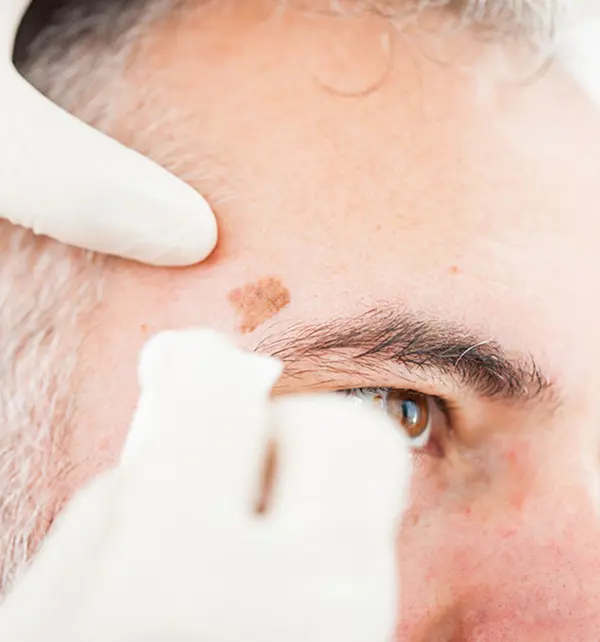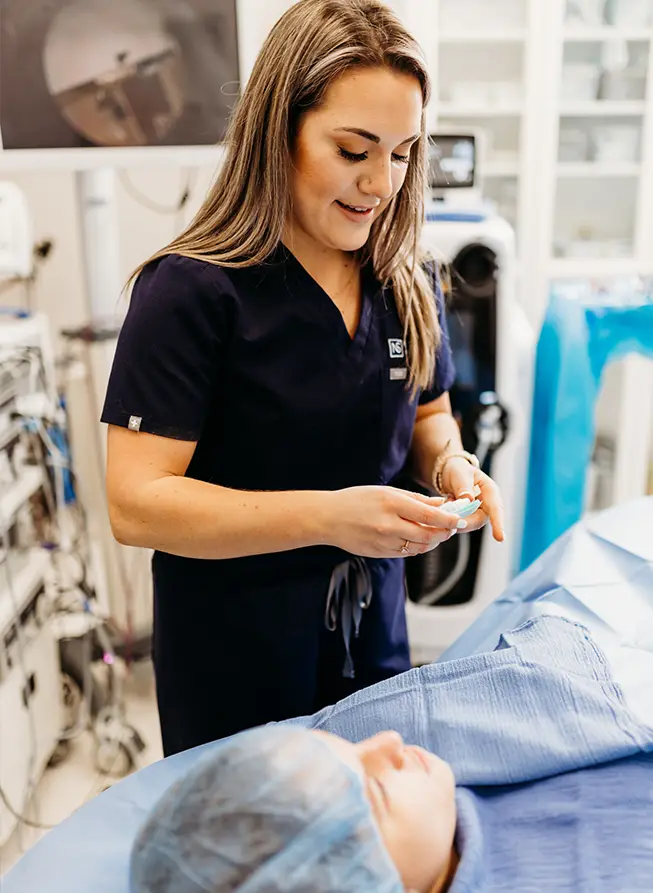
Our surgeons specialize in restoring natural facial aesthetics after skin cancer treatment.
Learning that you have skin cancer can be difficult, especially when it affects a sensitive area on your face. Dr. Hancock, Dr. Klimczak and Dr. Nachlas specialize in facial plastic and reconstructive surgery to preserve normal tissue and restore a natural appearance. Both are double board-certified and fellowship-trained, bringing exceptional skill to every skin cancer reconstruction procedure. You can trust our surgical team at the Nose and Sinus Institute of Boca Raton to repair facial defects with precision and care.

Reconstructive surgery is a procedure designed to repair irregularities resulting from the removal of cancerous lesions on the skin. Our physicians often collaborate with Mohs surgeons, who perform the initial excision of the cancerous tissue, allowing them to focus on the reconstruction. The procedure can be performed under local, intravenous, or general anesthesia, depending on the complexity of the case. The goal is to achieve an appearance and function as close as possible to the pre-surgery state.
During reconstruction, various techniques may be used depending on the size and location of the concern, these include:
Candidates for skin cancer reconstruction are individuals who have undergone or need to undergo excision of skin cancer on the face or neck. Suitable candidates include:

Recovery typically involves outpatient care, with most patients going home the same day. Our physicians may prescribe antibiotics to prevent infection, especially if skin flaps or grafts are used. Sutures are generally removed within a week, and additional wound care may be necessary for up to two weeks. Full recovery, including the resolution of swelling, can take several weeks to months. Our personalized approach ensures each patient receives detailed recovery instructions and ongoing support.
Restored facial aesthetics and improved self-confidence are some of the most notable benefits. Other advantages of reconstruction after skin cancer surgery include:
While generally safe, reconstructive surgery carries side effects such as swelling and temporary discomfort. The procedure also carry with it some potential risks which are significantly reduced in our expert team’s care. These include:
Our surgeons bring exceptional expertise to skin cancer reconstruction. Dr. Nachlas is renowned for his pioneering techniques in facial plastic surgery and has significantly contributed to advancements in reconstructive procedures. Dr. Hancock is celebrated for her meticulous attention to detail and innovative approaches to restoring natural appearance and function. Both surgeons are dedicated to providing outstanding results and personalized care, ensuring each patient in Boca Raton receives the highest level of treatment. Schedule your consultation today.
Conveniently located in Boca Raton, our ENT doctors serve Boca Raton and all surrounding communities in Palm Beach and Broward Counties
In general, there are 2 technical approaches to the removal of skin cancer when on the head and neck:
Also known as Mohs Micrographic Surgery, is a surgical technique used to treat skin cancer. This type of surgery is used to treat non-melanoma skin cancers, including basal cell carcinoma (BCC) and squamous cell carcinoma (SCC), as well as some types of melanomas. It is typically done by a specialized dermatologist who has specific training in Mohs Micrographic Surgery.
This refers to the excision of the skin cancer as well as an area of normal tissue surrounding it. The amount of normal tissue also excised with the cancer depends on the size, location, and type of skin cancer. This method may be appropriate for some types and locations of skin cancers, but is often not the preferred method if the skin cancer is near certain important facial structures such as the nose, lips, or eyes.
Following excision of the skin cancer by either of the above methods, skin cancer reconstruction can be performed.
There are several different types of skin cancers. The three most common forms of skin cancer include melanoma, basal cell carcinoma, and squamous cell carcinoma. Awareness has increased for all types leading to earlier diagnosis and treatment. Nonetheless, the most important way to lower your risk of getting any kind of skin cancer is to protect yourself from exposure to the sun’s harmful ultraviolet (UV) rays. You should practice sun safety when outdoors and avoid tanning beds, too! Additionally, you should perform regular skin checks on yourself and family by looking for moles and other skin changes.
The duration of the surgery depends on the size and complexity of the defect being reconstructed. On average, the procedure can take anywhere from 1 to 4 hours.
While our surgeons aim to minimize scarring, some degree of scarring is inevitable. However, scars typically fade over time and can often be placed in less visible areas. Our team uses advanced techniques to ensure the best cosmetic outcome.
Reconstruction can often be performed immediately after the excision of the skin cancer. This approach helps to reduce the overall recovery time and improve aesthetic outcomes. Your surgeon will discuss the best timing for your specific case.
In some cases, skin cancer reconstruction can be combined with other cosmetic procedures to enhance overall facial aesthetics. During your consultation, our surgeons will discuss all available options and help you decide on the best treatment plan.
The cost of skin cancer reconstruction can vary based on the complexity of the procedure and the specific techniques used. Many insurance plans cover the cost of reconstruction after skin cancer surgery. Our office staff can assist you with verifying insurance benefits and discussing payment options.
Take charge of your life today! Call us or submit an online form, and you will be speaking with one of our talented surgeons in no time.
(561) 939-7352